#crab nebula
Explore tagged Tumblr posts
Text

Crab Nebula from Visible to X-Ray ©
#space#nasa#chandra observatory#hubble telescope#stars#astrophotography#solar system#crab nebula#galaxy#planet#universe#astronomy#cosmos#night sky
1K notes
·
View notes
Text
Pride Flags Colorpicked from Nebulas











#nebulas#space#nasa#trifid nebula#crab nebula#lagoon nebula#astronomy#aroace#aro#ace#aromantic#arospec#aromantic spectrum#transgender#bisexual#asexual#bi#trans#color picked flags#colorpicked flags#color picked pride flags#colorpicked pride flags#colour picked flags#colourpicked flags#colour picked pride flags#colourpicked pride flags#lgbtq#lgbtqia
1K notes
·
View notes
Text



From the depths of the ocean to the most distant galaxies, we’re all connected! 💫 💙
Recently, @montereybayaquarium Executive Director Julie Packard and Space Telescope Science Institute Director Dr. Jennifer M. Lotz were honored with 2024 Clarke Foundation awards.
In celebration, the Aquarium has partnered with STScI to bring you images from outer space and Earth’s life-giving ocean. It’s in moments like these that we can pause to appreciate and be in awe of the world we live in. As John Steinbeck and Ed Ricketts wrote in “The Log from the Sea of Cortez”: “It is advisable to look from the tide pool to the stars and then back to the tide pool again.” ✨
Credit: NASA,ESA, and the Monterey Bay Aquarium.
#space#astronomy#stsci#science#nasa#universe#hubble#hubble space telescope#hubble telescope#clarke foundation#monterey bay aquarium#aquarium#oceans#earth#crab nebula#jelly fish#anemone#nudibranch#nebula#galaxies
263 notes
·
View notes
Text

From Asimov on Astronomy, 1976.
211 notes
·
View notes
Text
Y'all, I'm getting emotional.
One of my absolute favorite astronomical bodies is the Crab Nebula, or Messier 1. The Crab Nebula is a "planetary nebula", which means it's the enormous, beautiful corpse of a once-giant star. The star that formed the Crab Nebula went supernova and exploded in 1054, and was so bright at the time of its death that you could see it from Earth during the day - for almost a month. For that month, it was brighter than every single thing in the sky except the moon and the sun. Some of you have probably heard of it, or have at least seen this Hubble picture:
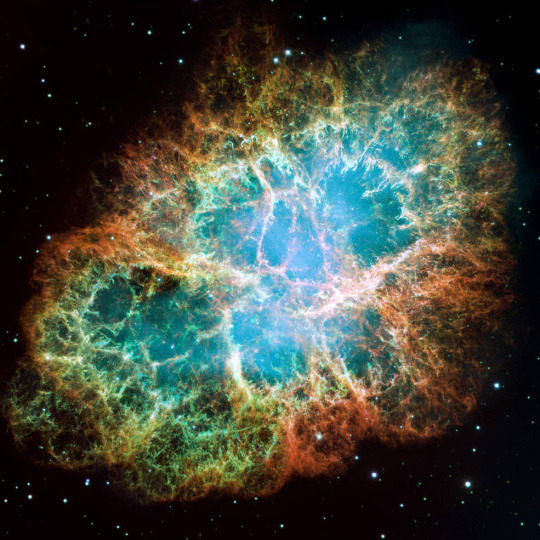
But how many of y'all have zoomed in?
Inside all of those lovely rainbow clouds is the supernova remnant - a neutron star. A neutron star is made of the densest possible material that we know of - any denser, and it'd collapse the rest of the way into a full-fledged black hole. Neutron stars are so unimaginably dense that they're not even made of an element, not really. The star at the center of the Crab Nebula is one, single atomic nucleus 12 miles in diameter, made entirely of close-packed neutrons. One teaspoon would weigh 10 million tons. Imagine taking a passenger jet, condensing it down to the size of a mote of dust, and then filling a spoon with that dust. And it spins too - 30 times a second. That spinning causes huge jets of material to eject from the poles at half the speed of light. The incredibly powerful magnetic field traps any stray particles and accelerates them in circular paths through the nebula. Just LOOK at this shit! See the ghosty shadows of the jets, stretching from the top left corner to the bottom right?
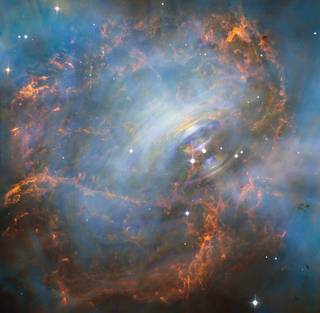
But what's really making me lose it is this Hubble timelapse. The star is making ripples. Its moving. Its been dead for almost a thousand years, but its still putting on its final, spectacular show.
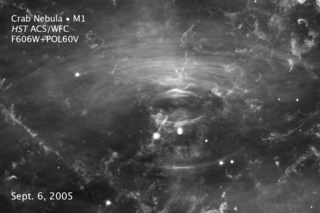
It never ceases to amaze me that the things we call "dead" stars are some of the most dynamic, energetic, and awe-inspiring objects in the universe. Normal stars are downright STAGNANT compared to what these so-called "stellar remnants" get up to. Maybe we shouldn't be thinking of them as dead stars, but as the next phase in a star's life. Just as caterpillars "end" their mundane lives and metamorphose into something new and strange and capable of flight, these stars destroy themselves to leave behind something far more exotic, playing at the edge of the laws of physics in ways we still don't fully understand.
#space#crab nebula#neutron star#supernova#god I fucking love neutron stars#ask me sometime about the first pulsar#hubble#spost#space post
749 notes
·
View notes
Text
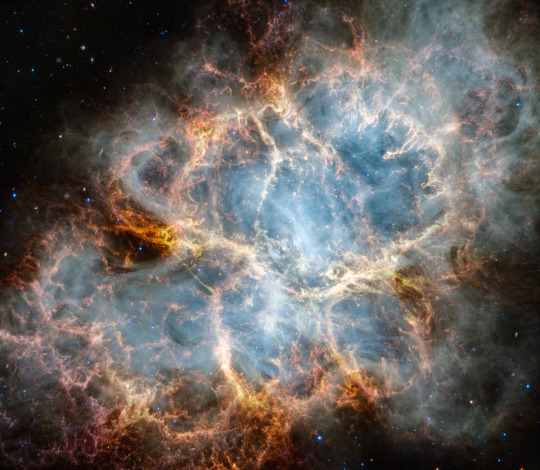
Crab Nebula as captured by the James Webb Space Telescope (30 October 2023)
#space#james webb space telescope#james webb#crab nebula#astrophotography#james webb images#nebula#nasa#cosmos#oh my gods this is so fucking beautiful#science#astronomy
447 notes
·
View notes
Note

Hi can you do this one please..

If we’re going by the colors in his vest, this picture of the Crab Nebula (also known as Messier 1) would fit!
This nebula, located in the constellation Tarus, is the remnants of a supernova that was observed by astronomers back in 1504 CE (or AD). It was bright enough, then, to be observed without a telescope—but has since dimmed.
Nebulas are sometimes called “star nurseries” because the materials within them are perfect for creating new stars!! It’s interesting to think about the fact that new stars made in nebulas have remnants of older stars within :D
29 notes
·
View notes
Text

M1: Filaments of the Crab Nebula - February 7th, 1997.
"The Crab Nebula is filled with mysterious filaments. It is the result of a star that exploded in 1054 AD. This spectacular supernova was recorded by the Chinese and, quite possibly, Anasazi Indian astronomers. The filaments are mysterious, because they appear to have less mass than expelled in the original supernova, and higher speed than expected from a free explosion. In the above picture, the colour indicates what is happening to the electrons in different parts of the Crab Nebula. Red indicates the electrons are recombining with protons to form neutral hydrogen, while green indicates the electrons are whirling around the magnetic field of the inner nebula. In the nebula's very center lies a pulsar: a neutron star rotating; in this case, 30 times a second."
30 notes
·
View notes
Text
The Crab Nebula

The Crab Nebula, cataloged as M1 and NGC 1952, is one of the most studied and well-known supernova remnants in the sky, located in the constellation Taurus. Here are some key points about it:
Origin: The Crab Nebula is the result of a supernova explosion observed in 1054 AD by Chinese, Japanese, and Arabic astronomers, who noted it as a "guest star" visible even in daylight for about 23 days. This event was one of the first recorded supernovas, making the Crab Nebula the first astronomical object identified as corresponding to a historically observed supernova explosion.
Structure and Composition:
It's an expanding cloud of gas and dust, approximately 11 light-years in diameter, located about 6,500 light-years from Earth. The nebula is expanding at a rate of about 1,500 kilometers per second.
The nebula includes intricate filaments that are mostly hydrogen, but it also contains elements like oxygen, sulfur, and iron, which were expelled during the supernova explosion.
Pulsar: At the heart of the Crab Nebula is the Crab Pulsar (PSR B0531+21), a neutron star that is the collapsed core of the original star. This pulsar rotates about 30 times per second, emitting beams of radiation that sweep across space like a lighthouse. This rapid rotation and strong magnetic field create a pulsar wind nebula, where charged particles are accelerated, producing synchrotron radiation visible in X-rays, gamma rays, and other wavelengths.
Scientific Significance:
The Crab Nebula has been crucial for understanding supernova remnants and pulsar behavior. Observations across different wavelengths (from radio to gamma rays) have provided insights into the physics of these phenomena.
It has been used for calibration in X-ray and gamma-ray astronomy due to its consistent brightness, though it's noted that its status as a calibration source has diminished over time.
Observations:
The nebula was first identified as a nebulous object by John Bevis in 1731 and later by Charles Messier in 1758, who cataloged it as M1 to avoid confusing it with comets. Its name derives from an 1844 drawing by William Parsons, 3rd Earl of Rosse, which somewhat resembled a crab.
Various telescopes have observed the Crab Nebula, including the Hubble Space Telescope, Chandra X-ray Observatory, Spitzer Space Telescope, and more recently, the James Webb Space Telescope, each adding layers of detail about its composition and dynamics.
Cultural Impact: Beyond its scientific value, the Crab Nebula has cultural significance, with its bright supernova having been potentially observed by many ancient cultures, including possibly Native American groups.
This nebula continues to be a subject of study due to its complex structure, energy emissions, and the history of its formation, contributing significantly to our understanding of stellar evolution, supernova dynamics, and the physics of neutron stars.
Grok AI
It should be added to the description made by Artificial Intelligence that despite the thorough study of the object, the distance to the Crab Nebula is still known with a very large margin of error — up to 25%. In more rigorous scientific articles, it is indicated as 6500 ± 1600 light years. Consequently, the linear size of the nebula is known to us with approximately the same relative spread of values.
At the end of the publication is a short video created based on a photograph of the Crab Nebula obtained using the JWST (James Webb Space Telescope):
youtube
27 notes
·
View notes
Text

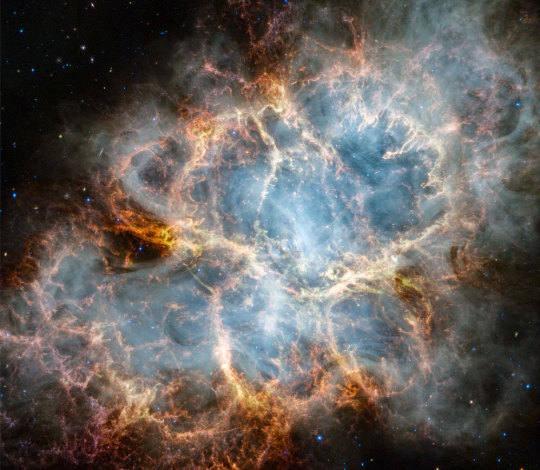
M1: The Incredible Expanding Crab ©
#nasa#apod#messeir 1#crab nebula#astrophotography#space#solar system#planet#galaxy#stars#universe#astronomy#cosmos
883 notes
·
View notes
Text

M1 the Crab Nebula. A supernova remnant and pulsar wind nebula 6,500 ly away sitting on the tip top of the left horn of Taurus the Bull. Had difficulty editing this one and not sure if I'm fully happy with it, but it'll do because I'm tired.
118 notes
·
View notes
Text

The James Webb Space Telescope’s observation of the Crab Nebula—the supernova remnant produced by one of the earliest supernova explosions ever recorded by humans—is now a printable poster!
The poster is available single- and double-sided. The double-sided version includes the image on the front and a description in both English and Spanish on the back.
Download this high-resolution poster: https://webbtelescope.pub/41VJ6rf
Credit: NASA, ESA, CSA, STScI; Joseph DePasquale (STScI), Elizabeth Wheatley (STScI).
115 notes
·
View notes
Text

The Crab Nebula, M1 // Tim Ray
#astronomy#astrophotography#nebula#emission nebula#supernova remnant#crab nebula#messier#messier 1#M1#NGC 1952#Taurus A#Sh2-244#taurus
84 notes
·
View notes
Text

M1, The Crab Nebula. Taken January 2025.
23 notes
·
View notes
Text
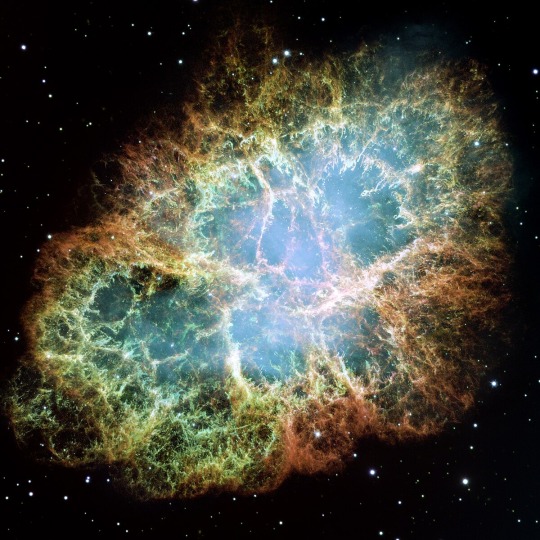
Messier 1, Also known as the Crab Nebula, a supernova remnant in the constellation of Taurus as seen by the Hubble Space Telescope. (Image Credits go to NASA/ESA)
193 notes
·
View notes
Text

The Crab Nebula (Webb/Chandra composite)
The Crab Nebula, the result of a bright supernova explosion seen by Chinese and other astronomers in the year 1054, is 6,500 light-years from Earth. At its center is a neutron star, a super-dense star produced by the supernova. As it rotates at about 30 times per second, its beam of radiation passes over the Earth every orbit, like a cosmic lighthouse.
17 notes
·
View notes